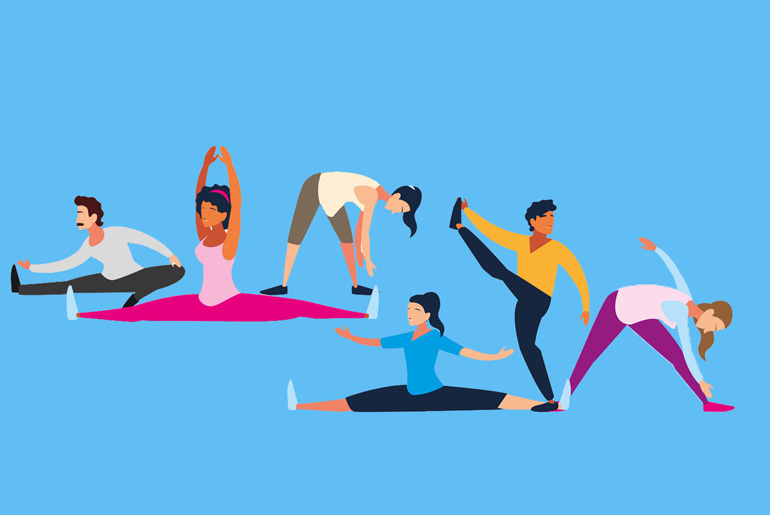Stretching is an essential component of physical fitness, promoting flexibility, injury prevention, and overall well-being. Different types of stretching, including passive, static, active, isometric, PNF, dynamic, and somatic stretching, offer various benefits and can be incorporated into daily routines based on individual needs and preferences. The best times to stretch include before working out for dynamic stretches to prepare muscles, after working out for slower, relaxing stretches to aid in muscle recovery, and periodically throughout the day to alleviate muscle tightness from prolonged sitting or standing.
Consistent stretching, ideally targeting each major muscle group at least two to three times per week, is recommended by health authorities like the American College of Sports Medicine (ACSM) to maintain flexibility and improve overall physical fitness.
Types of Stretching:
- Passive Stretching: In passive stretching, an external force, such as gravity, a partner, or a prop like a towel or resistance band, helps to facilitate the stretch. An example is using a towel to assist in a hamstring stretch. Passive stretching is commonly performed after a workout for relaxation.
- Static Stretching: Static stretching involves extending a limb to create a stretch sensation and holding it in that position for a period, typically 20 to 45 seconds. Unlike passive stretching, in static stretching, you’re supporting yourself in the stretch position. It’s commonly used after workouts and for relaxation.
- Active Stretching: Active stretching involves moving a limb into a stretched position using your own muscular power and then holding it there. An example is lifting a straight leg to stretch the hamstrings. Active stretching can be beneficial for individuals recovering from injuries as it incorporates gentle strength work.
- Isometric Stretching: Isometric stretching involves adding a static muscle contraction to a static or active stretch. This technique typically alternates between contracting the muscle for a short duration and stretching it. Isometric stretching can promote rapid improvements in flexibility by signaling the muscles to stretch further.
- Proprioceptive Neuromuscular Facilitation (PNF): PNF stretching is similar to isometric stretching but may involve shorter contraction times. It also includes contracting the muscle opposite to the one being stretched. PNF stretching can enhance flexibility and is often used in rehabilitation settings.
- Dynamic Stretching: Dynamic stretching involves controlled movements to move muscles through their full range of motion. It’s commonly used as part of a warm-up routine before a workout to prepare the body for movement.
- Somatic Stretching: Somatic stretching focuses on releasing muscular tension through gentle, natural movements without holding a stretch for a set length of time. It emphasizes tuning into the sensations of the muscles. An example is paying attention to how your head feels when letting it hang or arching your back upon waking.
Each type of stretching offers unique benefits and can be incorporated into a well-rounded flexibility routine based on individual needs and preferences.
Stretching Benefits:
- Improved Flexibility: Stretching regularly can increase flexibility, allowing for better movement and reduced risk of injury.
- Enhanced Range of Motion: Stretching helps to improve joint mobility and range of motion, making daily activities easier.
- Reduced Muscle Tension: Stretching can alleviate muscle tension and stiffness, promoting relaxation and stress relief.
- Better Posture: Stretching tight muscles can help improve posture by reducing muscle imbalances and allowing for proper alignment.
- Injury Prevention: Regular stretching can help prevent injuries by improving muscle elasticity and reducing the risk of strains and sprains.
- Improved Circulation: Stretching increases blood flow to the muscles, which can aid in recovery and promote overall circulation.
Stretches for Beginners:
- Neck Stretch: Gently tilt your head to one side, bringing your ear towards your shoulder until you feel a stretch on the opposite side of your neck. Hold for 15-30 seconds, then switch sides.
- Shoulder Stretch: Bring one arm across your body and gently press it towards your chest with the opposite hand. Hold for 15-30 seconds, then switch sides.
- Hamstring Stretch: Sit on the floor with one leg extended and the other bent. Reach towards your toes on the extended leg, keeping your back straight. Hold for 15-30 seconds, then switch legs.
- Quad Stretch: Stand tall and gently pull one foot towards your buttocks, feeling a stretch in the front of your thigh. Hold for 15-30 seconds, then switch legs.
- Calf Stretch: Stand facing a wall with one foot in front of the other. Lean forward, keeping your back leg straight, until you feel a stretch in your calf. Hold for 15-30 seconds, then switch legs.
- Chest Opener: Interlace your fingers behind your back and straighten your arms, lifting your chest and squeezing your shoulder blades together. Hold for 15-30 seconds.
Tips for Safe Stretching:
- Warm Up: Always warm up your muscles before stretching with light cardio or dynamic movements.
- Avoid Bouncing: Never bounce or force a stretch, as this can cause injury. Instead, stretch slowly and gradually.
- Hold Each Stretch: Hold each stretch for 15-30 seconds, breathing deeply and relaxing into the stretch.
- Don’t Overstretch: Stretch to the point of mild discomfort, but never to the point of pain.
- Stay Consistent: Incorporate stretching into your daily routine to reap the full benefits.
- Listen to Your Body: If you feel any sharp pain or discomfort while stretching, stop immediately.
Stretching should be a regular part of your fitness routine, whether you’re a beginner or an experienced athlete. By incorporating stretching into your daily routine, you can improve flexibility, prevent injuries, and enhance overall well-being.
Best time to stretch:
The best time to stretch depends on your goals and activities, but here are some recommended times to incorporate stretching into your routine:
- Before Working Out: Dynamic stretching is ideal before every workout to prepare your muscles for activity. Spend about five to ten minutes performing dynamic stretches to increase blood flow and flexibility, helping to prevent injury during exercise.
- After Working Out: After completing your workout, focus on slower, more relaxing stretching techniques such as passive and static stretching. These methods help lengthen the muscles and connective tissues, promoting flexibility and aiding in muscle recovery. They also assist your body in returning to a balanced state, known as homeostasis, by normalizing body temperature, heart rate, and blood pressure.
If You’ve Been in the Same Position for a Long Time: If you’ve been sitting or standing in the same position for an extended period, take breaks to stretch periodically throughout the day. This can help alleviate muscle tightness and stiffness commonly associated with prolonged sitting or standing. Whether you work at a computer, sit in a car, or stand for long periods, incorporating stretching breaks can help counteract the effects of sedentary behavior.
While these are suggested times to stretch, it’s important to listen to your body and stretch when it feels beneficial for you. Daily stretching is safe and effective for improving flexibility and overall physical fitness, so consider incorporating stretching into your daily routine, even on days when you’re not working out. Remember to perform stretches gently and avoid bouncing or forcing movements to prevent injury.
Disclaimer:
The information contained in this article is for educational and informational purposes only and is not intended as a health advice. We would ask you to consult a qualified professional or medical expert to gain additional knowledge before you choose to consume any product or perform any exercise.







